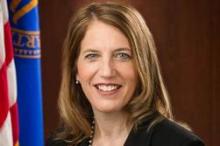As Medicare approaches its 50th anniversary next week, the federal program got some welcome financial news Wednesday: Its giant hospital trust fund will be solvent until 2030, and its long-term outlook has improved, according to a report from the program’s trustees.
But the report warned that several million Medicare beneficiaries could see their Medicare Part B monthly premiums skyrocket by 52% in January – from $104.90 to $159.30. Medicare Part B, which is paid for by a combination of federal funds and beneficiary premiums, generally covers physician and outpatient costs.
The huge rate hike is predicted because of a confluence of two factors: Medicare Part B costs increased more than expected last year, and Social Security is not expected to have a cost of living increase next year. By law, the cost of higher Medicare Part B premiums can’t be passed on to most Medicare beneficiaries when they don’t get a Social Security raise. As a result, the higher Medicare costs have to be covered by just 30% of Medicare beneficiaries. This includes the 2.8 million Medicare enrollees new to the program next year, 3.1 million Medicare beneficiaries with incomes higher than $85,000 a year, and 1.6 million Medicare beneficiaries who pay their premium directly instead of having it deducted from Social Security. An additional 9 million people affected by the higher rates are so called “dual eligibles” – those on Medicare and Medicaid. States pay the Medicare Part B premium for duals.
Medicare Part B premiums are set largely by a complicated formula written into law. The trustees’ predictions on premiums are typically close to the final rates that are announced each fall by the U.S. Department of Health & Human Services.
HHS Secretary Sylvia M. Burwell said she will examine her options and make a final decision on rates in October. “Seventy percent of enrollees in Part B will have no change in premiums,” she said at a briefing with other program trustees.
A senior government official, speaking only on background at a Treasury Department briefing on the report, said the projected premium increase in Part B is “atypical” and noted that outpatient health services were among those services that saw higher than expected costs last year. Another senior government official said Ms. Burwell has several “policy options” to lessen the premium increases but would not say what they are.
If the Social Security program determines in the next 2 months that a cost of living increase is needed for next year, that could diminish the premium hikes because they could be spread over millions more beneficiaries. But currently that is not expected.
Medicare advocacy groups expressed concern about the projected rate increase. Judith Stein, executive director of the Center for Medicare Advocacy, said she is concerned the predicted Medicare Part B premium hike signals that, for many, the program is becoming too expensive. She said the higher premiums will force more seniors to join Medicare Advantage, which offers lower costs but also restricts which providers they can use.
“I am concerned that people will start to rail against Medicare rather than love it, as they have for 50 years,” Ms. Stein said.
“We are pleased to see that 70% of people with Medicare are expected to have a stable Part B premium, and it is concerning to us that 30% could see an increase,” said Stacy Sanders, federal policy director at the Medicare Rights Center. “When the final premium amounts are released, we are committed to educating people about their Part B premium, and most importantly, about the potential availability of [programs] that can help with the cost of the Part B premium.”
The possible huge Medicare Part B premium increase overshadowed a generally positive report about the financial health of the Medicare Part A, which covers hospital costs.
The trustees report noted that the financial health of the program is being helped by factors such as an improved economy, while other factors such as more seniors in private Medicare Advantage are increasing costs. The government pays higher costs for those in Medicare Advantage, which is managed care.
While 2030 remained unchanged as the year that the program’s funds would be exhausted, the report said the program’s long-term outlook was improved. That improvement was largely due to assumptions that health costs will grow at a slower rate after 2050.
In 2014, Medicare provided health insurance coverage to 53.8 million people at a cost of $613 billion – roughly the GDP of Argentina. The average value of the Medicare benefit per enrollee was $12,432, about 2% higher than last year.


